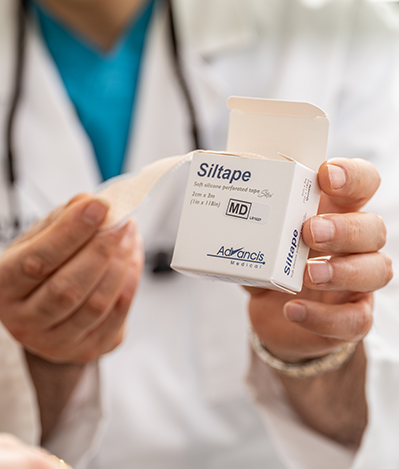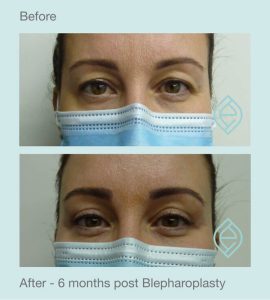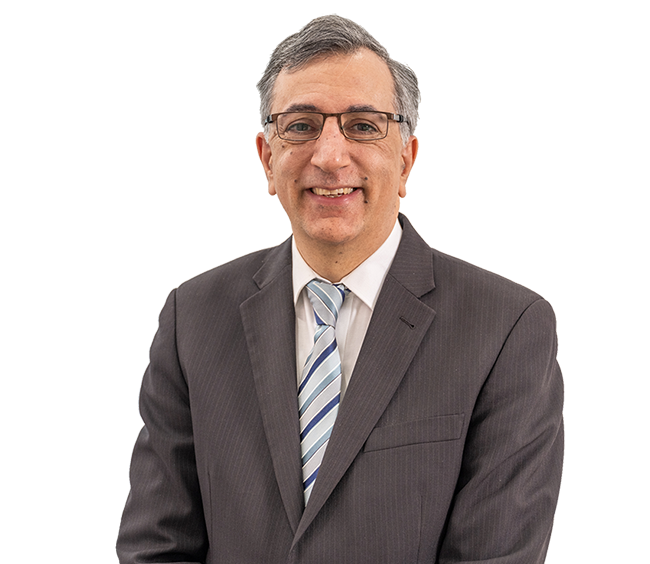Procedure Spotlight
- Reduces the heavy and tired feel of the upper eyelid
- Can improve vision by removing the excess skin in the eyelids and reduce headaches caused by overactivity of the forehead muscles pulling the eyebrows up to compensate
- Can help revitalise and rejuvenate the face
- Reduces tired & sagging upper eyelid appearance
- Reduces puffiness and bags in the lower eyelids
- Provides eyelid balance and symmetry
- Pain after surgery is minimal with over the counter pain medication usually sufficient
As part of aging, we lose elasticity of the skin. This combined with the effect of gravity can cause skin to stretch and result in excess skin and/or bags around the eyes.
Around the upper eyelids it is characterised by excess drooping skin (hooded look) and in some cases it can interfere with vision.
Around the lower eyelids it causes wrinkles and puffy bags that are responsible for the sleepy, tired and aged look.
Upper eyelid blepharoplasty can help revitalise the face and reduce the heavy, sagging upper eyelid appearance. It can also improve vision and reduce headaches caused by excess skin in the eyelids.
Lower eyelid blepharoplasty can help freshen and rejuvenate the face. It can also reduce puffiness and bags under the eyelids, giving you a more youthful and rested appearance.

Technique
Upper eyelid blepharoplasty
The procedure is usually performed as a day-surgery without the need for an overnight stay. It usually takes around 2-3 hours to complete. Dr Safvat surgically removes the excess skin, muscle and fat from the upper eyelid as needed. Upper lid blepharoplasty may be combined with lower blepharoplasty if needed.
Lower eyelid blepharoplasty
The procedure is more involved than upper-eyelid surgery and patients are required to stay overnight in hospital. Dr Safvat uses an incision on the inside of the eye (trans-conjunctival approach) to deal with the excess fat in the lower eyelid. The excess external skin is then removed (as needed) through an external incision just under the eyelashes. This way the muscles around the eye are left intact, which greatly reduces the risk of complications. In addition, young people with good skin elasticity may not have excess skin that needs excision. Therefore, they will not have the external scar. The lower eyelid is then supported and suspended to the outer corner of the eye with internal sutures. This is called a canthopexy / canthoplasty. Dr Safvat believes in conservative removal of orbital fat to avoid creating a gaunt look.

Eyelid surgery is done under a light anaesthetic in a fully accredited private hospital. Dr Safvat only works with highly trained anaesthetists accredited with the Australian and New Zealand College of Anaesthetists.
Procedure Snapshot
Upper Blepharoplasty
| Anaesthetic Type: | General Anaesthetic (light) |
| Length of Surgery: | 2 hours approximately |
| Stay in Hospital: | Day stay only |
| Downtime: | 1-2 weeks depending on type of work |
Lower Blepharoplasty
| Anaesthetic Type: | General Anaesthetic |
| Length of Surgery: | 3 hours approximately |
| Stay in Hospital: | 1-2 night stay |
| Downtime: | 1-2 weeks depending on type of work |
Recovery
The eyelids will be swollen and bruised for 1-2 weeks. A cold compress can be used to reduce these effects after surgery. Sleeping with your head in an elevated position for the first week can also help reduce swelling a lot faster. Patients need to have 1-2 weeks off work to rest at home. You also won’t be able to do any heavy lifting or exert yourself for 3-4 weeks. However, some light walking a few days after your procedure can help with the healing process.
Your eyes might feel quite dry and sore for a week or two. Eyedrops or gels can be used to keep the eyes moisturised until they’re fully healed.

During your time at home, it’s best to get as much rest as possible.
Preparation
Prior to your blepharoplasty procedure, your medical history as well as your eyes will need to be evaluated. This will take place during your consultation. Dr Safvat insists patients stop smoking for several weeks before surgery. Nicotine and smoking are known to affect the effectiveness of the recovery process and can cause issues such as wound breakdown. We will also provide you with a list of medications and supplements that will need to be cut out prior to surgery. Certain supplements and medications can cause excess bleeding and bruising.
Scars
Blepharoplasty incisions can take up to 6-12 months to heal completely but will be more noticeable for the first six weeks. There is also bruising that will be present during the first few weeks. Dr Safvat makes the incisions along the natural fold of each eyelid, which also keeps the scars practically invisible.
Dr Safvat will also provide a Scar Management Program after the procedure for you to follow which will help to minimise scars.

Complications
While all care and diligence is taken by Dr Safvat to minimise or avoid complications, any surgical procedure can be associated with some general complications and/or specific complications related to the surgery you are having. Choosing a Specialist Plastic Surgeon such as Dr Safvat and having your procedure done in an accredited hospital minimises risks as does using an accredited Anaesthesist.
Some general surgical potential complications are:
• Infection that may require antibiotics (Dr Safvat prescribes all patients antibiotics after surgery to minimise this risk).
• Fluid build-up under the skin (seroma).
• Allergic reaction to dressings and other items used during the procedure.
• The formation of blood collection (haematoma) which could require additional surgery.
• Scars heal differently in different people. Some people are genetically prone to develop keloid scars. Hypertrophic scars develop when there is a complication in the healing process. Whilst not ideal, there is no threat to your health if you develop these.
• Anyone can have a heart attack or stroke from a clot. This risk is slightly increased with anaesthetics.
Some potential complications related to Blepharoplasty surgery specifically are:
• Your vision could be slightly blurry after surgery but this will rectify on its own.
• Your eyes may also feel gritty or dry which can be helped with eye drops.
• Asymmetry of the eyelids – though all care is taken to prevent this.
• Noticeable scarring of the incisions.
• In rare cases, changes in vision may be long lasting or permanent.
Dr Safvat will discuss potential complications with you in detail during your consultation.
Cost
Upper Blepharoplasty, if done for functional reasons, has an item number classifying it as medically required. Patients need to meet certain criteria for the procedure to be classified as medically required. Dr Safvat will determine this during the first consultation. In some borderline cases, Dr Safvat may send you to an Optometrist for specific visual field testing to ensure you get the correct classification. If the procedure is classified as medically required there will still be an out-of-pocket cost, however patients should get a rebate from Medicare and their health fund as well as be covered for the hospital costs depending on their level of private health insurance cover. Conversely, if it is done for cosmetic reasons, the surgery will not be covered by Medicare or health funds. Lower Blepharoplasty is considered a cosmetic procedure.
Dr Safvat’s team will discuss all costs associated with the procedure after your first consultation.
Frequently asked questions
Who is suitable for Eyelid Surgery?
Generally speaking, anyone who has signs of ageing in the eyelid area, as a result of excess skin or droopy eyelids are a good candidate for upper blepharoplasty surgery. The skin of the eyelids can become loose, saggy and hang over the eye obstructing vision. In upper eyes it is a hooded appearance and in the lower eyes it presents as bags and dark circles under the eyes.
Can Blepharoplasty remove wrinkles and dark circles around the eyes?
Eyelid surgery only addresses excess skin and fat around the eyes. However, since the skin does tighten, some fine lines may be reduced but not all. If your dark circles were being caused by large undereye bags, there might be a slight improvement.
Do I need Upper Eyelid Surgery or a Brow Lift?
This will depend on whether the primary concern is excess skin on the upper eyelids or if the brow’s position has lowered over time. If excess eyelid skin is the problem, eyelid surgery is the solution. If the brow needs to be lifted, a browlift (surgical or through injectables) is the solution.
Are Blepharoplasty Results Permanent?
It is uncommon for a patient to require a second eyelid lift but it is possible. However, since the ageing process will continue, eyelid skin will slowly start to sag again over time.
Where does Dr Safvat perform this procedure?
Dr Safvat does the Blepharoplasty procedure in Sydney region (Sutherland Shire and Inner West) as well as in the Southern Highlands, NSW. He only operates in fully accredited Private Hospitals, these being Kareena Private Hospital (Caringbah), Strathfield Private Hospital, Southern Highlands Private Hospital (Bowral) and Ramsay Surgical Centre Miranda.
Before and Afters



You must be over 18 years to view Dr Safvat’s before and after image galleries
Dr Safvat is a fully qualified Specialist Plastic Surgeon. Every patient is unique and results may vary. Any surgical procedure carries risks which need to be discussed with your doctor to ensure you are fully informed and realistic outcomes have been explained. Before proceeding, you should seek a second opinion from an appropriately qualified health practitioner.
These photos are of actual patients of Dr Safvat. Each has given consent for the photos to be used by Dr Safvat only.
DR ANDRE SAFVAT (MED1155201)
Registered Medical Practitioner, Specialist Plastic Surgeon (specialist registration in Surgery – Plastic surgery).
Dr André Safvat – Specialist Plastic Surgeon
Renowned for his dedication to his patients, his attention to detail and impeccable outcomes, Dr Safvat’s unparalleled expertise is reflected in the quality, professionalism and dedication of every member of our team.


